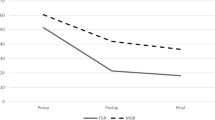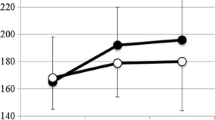Abstract
Purpose
Early-onset scoliosis (EOS) has always been a challenging situation for spine surgeons. The aim of treatment is to control the direction of curve progression to allow for the complete development of lungs. Among all the growth constructs available, traditional growth rods (TGR) and magnetically controlled growth rods (MCGR) are most widely used. The MCGR has been introduced a few years back and there is a dearth of long-term follow-up studies. The purpose of this study is to compare the effectiveness of TGR and MCGR for the treatment of EOS.
Methods
All patients of EOS managed with either TGR or MCGR were included in the study. The patients managed with other methods or having follow-up < 2-years were excluded from the study. A total of 20 patients were recruited in the MCGR group and 28 patients were recruited in the TGR group. Both groups were matched by etiology, gender, pre-operative radiological parameters, and complications including unplanned surgeries.
Results
The mean age in our study was 7.90 years in the MCGR group and 7.46 years in the TGR group. The mean duration of follow-up in the MCGR group was 50.89 months and in the TGR group 94.2 months. Pre-operative cobb’s angle in the coronal plane and T1–S1 were comparable in both groups with a mean cobb’s angle of 65.4 in MCGR and 70.5 in TGR. The mean T1–S1 length in the MCGR group was 36.1cms and in the TGR group was 35.2 cms (p = 0.18). The average increase in T1–S1 length was 1.3 cm/year in the TGR group and 1.1 cm/year in the MCGR group (p > 0.05). The TGR patients underwent 186 open lengthening surgeries and 11 unplanned surgeries for various complications. The MCGR group has 180 non-invasive lengthening with only 4 unplanned returns to OT for various causes.
Conclusion
The curve correction was similar in both TGR and MCGR groups. The average T1–S1 length achieved on final follow-up was similar in both groups. The MCGR patients have attained similar correction with fewer invasive procedures and lesser complications compared to the TGR group.


Similar content being viewed by others
References
Yang S, Andras LM, Redding GJ et al (2016) Early-onset scoliosis: a review of history, current treatment, and future directions. Pediatrics 137(1):e20150709
Smith JR, Samdani AF, Pahys J et al (2009) The role of bracing, casting, and vertical expandable prosthetic titanium rib for the treatment of infantile idiopathic scoliosis: a single-institution experience with 31 consecutive patients. Clinical article J Neurosurg Spine 11(1):3–8
Moe JH, Kharrat K, Winter RB et al (1984) Harrington instrumentation without fusion plus external orthotic support for the treatment of difficult curvature problems in young children. Clin Orthop Relat Res 185:35–45
Goldberg CJ, Gillic I, Connaughton O et al (2003) Respiratory function and cosmesis at maturity in infantile-onset scoliosis. Spine 28(20):2397–2406
Skaggs DL, Akbarnia BA, Flynn JM et al (2014) Chest wall and spine deformity study group; growing spine study group; pediatric orthopaedic society of north america; scoliosis research society growing spine study committee. A classification of growth friendly spine implants. J Pediatr Orthop 34(3):260–274
Varley ES, Pawelek JB, Mundis GM Jr, Oetgen ME, Sturm PF, Akbarnia BA (2021) Pediatric spine study group; Yaszay B. The role of traditional growing rods in the era of magnetically controlled growing rods for the treatment of early-onset scoliosis. Spine Deform 9(5):1465–1472. https://doi.org/10.1007/s43390-021-00332-4
Akbarnia BA, Mundis GM (2019) Magnetically controlled growing rods in early onset scoliosis. Indications, timing and treatment. Orthopäde 48:477–485. https://doi.org/10.1007/s00132-019-03755-0
Guiroy A, Sícoli A, Masanés NG et al (2018) How to perform the Wiltse posterolateral spinal approach: technical note. Surg Neurol Int 14(9):38. https://doi.org/10.4103/sni.sni_344_17
Williams BA, Matsumoto H, McCalla DJ et al (2014) Development and initial validation of the classification of early-onset scoliosis (C-EOS). J Bone Joint Surg Am 96:1359e67
Klyce W, Mitchell SL, Pawelek J et al (2020) Characterizing use of growth-friendly implants for early-onset scoliosis: a 10-year update. J Pediatr Orthop 40(8):e740–e746. https://doi.org/10.1097/BPO.0000000000001594
Cheung KM, Cheung JP, Samartzis D et al (2012) Magnetically controlled growing rods for severe spinal curvature in young children: a prospective case series. Lancet 379(9830):1967–1974. https://doi.org/10.1016/S0140-6736(12)60112-3
Cheung JPY, Sze KY, Cheung KMC et al (2021) The first magnetically controlled growing rod (MCGR) in the world—lessons learned and how the identified complications helped to develop the implant in the past decade: case report. BMC Musculoskelet Disord 22(1):319. https://doi.org/10.1186/s12891-021-04181-0.PMID:33794851;PMCID:PMC8015050
Bouthors C, Gaume M, Glorion C et al (2019) Outcomes at skeletal maturity of 34 children with scoliosis treated with a traditional single growing rod. Spine 44(23):1630–1637. https://doi.org/10.1097/BRS.0000000000003148
Akbarnia BA, Pawelek JB, Cheung KM et al (2014) Traditional growing rods versus magnetically controlled growing rods for the surgical treatment of early-onset scoliosis: a case-matched 2-year study. Spine Deform 2(6):493–497. https://doi.org/10.1016/j.jspd.2014.09.050
Helenius IJ (2020) Standard and magnetically controlled growing rods for the treatment of early onset scoliosis. Ann Transl Med 8(2):26. https://doi.org/10.21037/atm.2019.09.72
Srivastava A, Pandita N, Gupta A et al (2023) Use of intra-operative internal distraction for the application of magnetically controlled growth rods (MCGR): a technique for maximizing correction in the rigid immature spine during index surgery. Spine Deform 11(1):225–235. https://doi.org/10.1007/s43390-022-00579-5
Dimeglio A, Canavese F (2012) The growing spine: how spinal deformities influence normal spine and thoracic cage growth. Eur Spine J 21(1):64–70. https://doi.org/10.1007/s00586-011-1983-3
Cengiz B, Ozdemir H, Sakaogullari A et al (2021) Traditional dual growing rod technique in the management of early onset scoliosis and its effects on spinal growth and lung development: the mid-term prospective results. Cureus 13(4):e14422. https://doi.org/10.7759/cureus.14422
Shah SA, Karatas AF, Dhawale AA et al (2014) The effect of serial growing rod lengthening on the sagittal profile and pelvic parameters in early-onset scoliosis. Spine 39(22):E1311-7. https://doi.org/10.1097/BRS.0000000000000565
Ilharreborde B, Ponchelet L, Sales de Gauzy J et al (2022) How does magnetically controlled growing rods insertion affect sagittal alignment in ambulatory early onset scoliosis patients? Eur Spine J 31(4):1036–1044. https://doi.org/10.1007/s00586-021-07071-0
Erdoğan S, Polat B, Atıcı Y et al (2019) Comparison of the effects of magnetically controlled growing rod and tradiotinal growing rod techniques on the sagittal plane in the treatment of early-onset scoliosis. J Korean Neurosurg Soc 62(5):577–585. https://doi.org/10.3340/jkns.2019.0094
Kwan KYH, Alanay A, Yazici M et al (2017) Unplanned reoperations in magnetically controlled growing rod surgery for early onset scoliosis with a minimum of two-year follow-up. Spine 42(24):E1410–E1414. https://doi.org/10.1097/BRS.0000000000002297
Jones CS, Stokes OM, Patel SB et al (2015) Actuator pin fracture in magnetically controlled growing rods: two cases. Spine J 16(4):e287-291. https://doi.org/10.1016/j.spinee.2015.12.020
Cheung JPY, Yiu KKL, Samartzis D et al (2017) Rod lengthening with the magnetically controlled growing rod: factors influencing rod slippage and reduced gains during distractions. Spine 43(7):E399–E405. https://doi.org/10.1097/BRS.0000000000002358
Akbarnia BA, Breakwell LM, Marks DS et al (2008) Dual growing rod technique followed for three to eleven years until final fusion: the effect of frequency of lengthening. Spine 33:984–90
Gardner A, Beaven A, Marks D et al (2017) Does the law of diminishing returns apply to the lengthening of the MCGR rod in early onset scoliosis with reference to growth velocity? J Spine Surg 3(4):525–530. https://doi.org/10.21037/jss.2017.08.16
Lampe LP, Schulze Bövingloh A, Gosheger G et al (2019) Magnetically controlled growing rods in treatment of early-onset scoliosis: a single center study with a minimum of 2-year-follow up and preliminary results after converting surgery. Spine 44(17):1201–1210. https://doi.org/10.1097/BRS.0000000000003048
Obid P, Yiu K, Cheung K et al (2021) Magnetically controlled growing rods in early onset scoliosis: radiological results, outcome, and complications in a series of 22 patients. Arch Orthop Trauma Surg 141(7):1163–1174. https://doi.org/10.1007/s00402-020-03518-z
Funding
The author did not receive support from any organization for the submitted work.
Author information
Authors and Affiliations
Corresponding author
Ethics declarations
Conflict of interest
The authors have no relevant financial or non-financial interests to disclose.
Additional information
Publisher's Note
Springer Nature remains neutral with regard to jurisdictional claims in published maps and institutional affiliations.
Rights and permissions
Springer Nature or its licensor (e.g. a society or other partner) holds exclusive rights to this article under a publishing agreement with the author(s) or other rightsholder(s); author self-archiving of the accepted manuscript version of this article is solely governed by the terms of such publishing agreement and applicable law.
About this article
Cite this article
Gupta, A., Srivastava, A., Pandita, N. et al. Comparison of traditional growth rods and magnetically controlled growing rods in early-onset scoliosis: a case-matched mid term follow-up study. Eur Spine J (2024). https://doi.org/10.1007/s00586-024-08301-x
Received:
Revised:
Accepted:
Published:
DOI: https://doi.org/10.1007/s00586-024-08301-x




